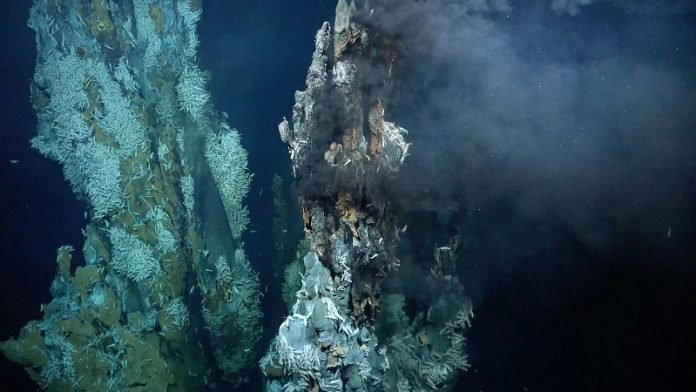
Scientists made a fascinating discovery during their first scientific expedition aboard the research vessel Falkor (too).
They have found three new hydrothermal vent fields along the Mid-Atlantic Ridge, which stretches over 434 miles.
The scientific team consisted of 11 institutions from the United States, Canada, and France, and they used advanced ocean technologies to make this discovery.
They used autonomous and remotely operated underwater vehicles, which resulted in the mapping of 65 square miles (170 square kilometers) of the seafloor at a one-meter scale resolution.
This area is roughly the size of Manhattan Island.
Hydrothermal vents are underwater geysers that emit hot water and minerals. These vents are found in places where the Earth’s tectonic plates are spreading apart, like along the Mid-Atlantic Ridge.
The discovery of these active hydrothermal vents is the first on this section of the Mid-Atlantic Ridge to be found in over 40 years. One of the discovered vent fields was located at the Puy des Folles volcano and has five active sites over 6.95 square miles (18 square kilometers).
High-temperature ‘black smoker’ vents were also found at the Grappe Deux vent system and Kane Fracture Zone.
“This cruise exceeded expectations with the discovery of so many amazing hydrothermal vents vibrant with life,” said Dr. Jyotika Virmani, executive director of Schmidt Ocean Institute.
“We are delighted with the new capability that Falkor (too) brings to the ocean science community, including the ability to put multiple different types of technology in the water simultaneously. The dedication of the scientists and crew, along with the capabilities of the ship, was evident in the success of this expedition and we look forward to more.”
The discovery of hydrothermal vents is important because they are home to many different types of marine life.
These vents are rich in metal sulfide deposits, which are often affiliated with copper and zinc. In exploring the vents for the first time, scientists found rich biological communities.
The vents were teeming with marine life including massive swarms of vent shrimp and a rare sighting of big-fin squid.
Many species found on vents live off chemical energy (chemosynthesis) instead of energy from sunlight, which doesn’t reach those depths.
The Mid-Atlantic ridge is a target area for deep-sea mining, which is the process of extracting minerals from the ocean floor. All mineral-resources-related activities in the area are regulated by the International Seabed Authority, established by the United Nations. The ISA is currently considering whether to allow deep-sea mining.
Scientists are still learning about how these ecosystems function and the role they play in cycling carbon on our planet.
The impacts deep-sea mining would have on hydrothermal vent ecosystems is unknown, and the discovery of active marine life underscores the need for more research to understand the effects.
Dr. David Butterfield, a Principal Research Scientist, stated that the very limited extent of hydrothermal vent habitat means that sites with active venting and chemosynthetic vent fauna communities should be excluded from mining.
The inaugural 40-day expedition on R/V Falkor (too) began in March, and the new vessel will be utilized for global ocean exploration, focused on a new region of the world each year. The next expedition will begin on April 17 exploring deep sea coral.
All in all, the discovery of these hydrothermal vents is an exciting breakthrough for the scientific community.
These vents are not only rich in minerals but also teeming with marine life. Scientists are still learning about these ecosystems, and the discovery of active marine life underscores the need for more research to understand the effects of deep-sea mining on these ecosystems.
The new research vessel Falkor (too) will be used for global ocean exploration, and the next expedition will explore deep-sea coral
Written by Schmidt Ocean Institute.



